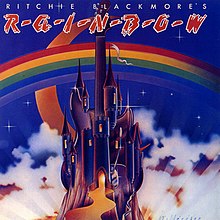Ritchie Blackmore's Rainbow
| Ritchie Blackmore's Rainbow | |||||
|---|---|---|---|---|---|

Cover art by David Willardson
|
|||||
| Studio album by Rainbow | |||||
| Released | 4 August 1975 | ||||
| Recorded | Musicland Studios, Munich, Germany, 20 February to 14 March 1975 | ||||
| Genre | Heavy metal | ||||
| Length | 36:54 | ||||
| Label | Oyster (UK) Polydor (rest of the world) |
||||
| Producer | Ritchie Blackmore, Martin Birch, Ronnie James Dio | ||||
| Rainbow chronology | |||||
|
|||||
| Ronnie James Dio chronology | |||||
|
|||||
| Singles from Ritchie Blackmore's Rainbow | |||||
|
|||||
| Professional ratings | |
|---|---|
| Review scores | |
| Source | Rating |
| AllMusic | |
| Rolling Stone | (unfavorable) |
| Sputnikmusic | |
Ritchie Blackmore's Rainbow (sometimes stylised Ritchie Blackmore's R-A-I-N-B-O-W) is the first album by British rock band Rainbow, released in 1975.
During studio sessions in Tampa Bay, Florida on 12 December 1974, Blackmore originally planned to record the solo single "Black Sheep of the Family"- a cover of a track by the band Quatermass from 1970 - and the newly composed "Sixteenth Century Greensleeves", which was to be the B-side. Other musicians involved included singer/lyricist Ronnie James Dio and drummer Gary Driscoll of blues rock band Elf, and cellist Hugh McDowell of ELO. Satisfied with the two tracks, Blackmore decided to extend the sessions to a full album.
The other members of Elf, keyboardist Micky Lee Soule and bassist Craig Gruber, were used for the recording of the album in Musicland Studios in Munich, Germany during February and March, 1975. Though it was originally planned to be a solo album, the record was billed as Ritchie Blackmore's Rainbow, and later progressed as a new band project. Blackmore and Dio did promotional work for the album. Shortly after the album was released, all Elf members (except Dio) were sacked and Blackmore recruited new musicians for subsequent Rainbow albums. This first line-up never performed live, and the live photos used in the album art are of Blackmore while with Deep Purple and of Elf playing live.
The last track of the album, "Still I'm Sad", is an instrumental cover of a song by The Yardbirds from their 1965 album Having a Rave Up with The Yardbirds. "Catch the Rainbow" uses a similar chord progression and vocal melody to Jimi Hendrix's "Little Wing" from the 1967 album Axis: Bold as Love.
...
Wikipedia
